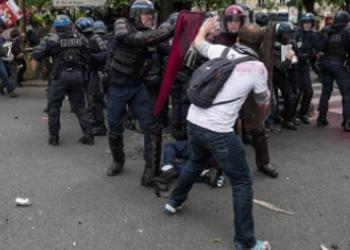
The Use of Reasonable Force in Arresting Protestors Engaged in Unlawful Protests
While individuals have the right to publicly protest, law enforcement has a right to arrest the protestors when they seek to prevent a duly installed government entity from performing its lawful functions. The use of reasonable force in arresting protestors engaging in unlawful protests is constitutional
In July, 2018, Tasha Williamson and others participated in what was referred to as a “die-in” at a city council meeting in National City. The purpose of this demonstration was to protest the death of one Earl McNeil; a black man who died while in police custody. (See Note, below.) The protestors in general disrupted the meeting by chanting from the audience. Williamson and five others, however, took it a step further by moving up to the public speaker podium in front of the city council members where they laid down on the floor around the podium, showing their red-painted “bloody hands” while chanting; “I am Earl McNeil,” and, “You have blood on your hands.” The protestors ignored the mayor’s call for order, so the council meeting was adjourned. Meanwhile, National City police officers warned Williamson and the other protestors around the podium that they would be arrested if they didn’t back away. (Getting arrested, of course, is exactly what they wanted.) The six protestors around the podium all ignored the officers’ repeated requests to leave, acting as “dead weight” instead, refusing to cooperate with being physically removed. The officers, therefore, pulled or carried them out, one by one. National City Officers Lucky Nguyen and John McGough drew Williamson as the demonstrator they were responsible for removing. Handcuffing her with her wrists behind her back, they brought her up to a seated position. Attempting to lift her to a standing position, they lost their grip and she rolled back to the ground, onto her stomach. So the officers tried again, one officer on each arm, lifting her back to a standing position. But because Williamson wouldn’t support her own weight, the officers had to pull her backwards by her arms and wrists while she remained in what resembled a seated position. In the twelve seconds it took to drag her through the room to the exit, Williamson’s chanting reverted to a continuous scream. At the exit door, Officer McGough released Williamson’s upper right arm, leaving Officer Nguyen to drag her by her left wrist and forearm through the doorway. In the hallway outside the meeting room, Williamson complained that they had hurt her shoulder. So the officers “double-cuffed” her to lessen the tension on her arms and make her more comfortable. Given her complaints of pain, an ambulance was called, but she declined a trip to the hospital. So she was taken to jail instead. After her release the next morning, Williamson drove herself to the hospital where it was determined that she had suffered a sprained wrist, mild swelling, and a torn rotator cuff (although there was some question whether her rotator cuff had been injured here, or during a prior arrest, which was the subject of a different lawsuit). Williamson sued the officers in federal court under 42 U.S.C. § 1983 and California’s Tom Bane Civil Rights Act (Cal. Civ. Code § 52.1), alleging that the officers had used excessive force against her in violation of the Fourth Amendment. When the district court denied the officers’ motion for summary judgment (i.e., to dismiss the lawsuit), the officers (and the City of National City) appealed.





